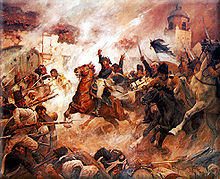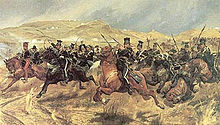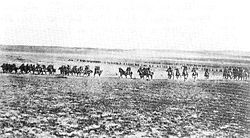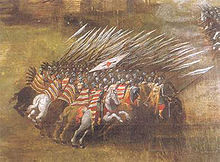- Charge (warfare)
-
Charge 
Romanticized painting of O'Higgins' charge at the Battle of Rancagua during the Chilean War of IndependenceEra Prehistoric – Modern Battlespace Land Weapons Cavalry, Infantry Type Maneuver warfare Strategy Operational A charge is a maneuver in battle in which soldiers advance towards their enemy at their best speed in an attempt to engage in close combat. The charge is the dominant shock attack and has been the key tactic and decisive moment of most battles in history. Modern charges usually involve small groups against individual positions (such as a bunker) instead of large groups of combatants charging another group or a fortified line.
Contents
Infantry charges
Ancient charges
It may be assumed that the charge was practised in prehistoric warfare, but clear evidence only comes with later literate societies. The tactics of the classical Greek phalanx included an ordered approach march, with a final charge to contact [1]
Highland charge
In response to the introduction of firearms, Irish and Scottish troops at the end of the 16th century developed a tactic that combined a volley of musketry with a rapid close to close combat using swords. Initially successful, it was countered by effective discipline and the development of defensive bayonet tactics.[2]
Bayonet charge
The development of the bayonet in the late 17th century led to the bayonet charge becoming the main infantry charge tactic through the 19th century and into the 20th. As early as the 19th century, tactical scholars were already noting that most bayonet charges did not result in close combat. Instead, one side usually fled before actual bayonet fighting ensued. The act of fixing bayonets has been held to be primarily connected to morale, the making of a clear signal to friend and foe of a willingness to kill at close quarters.[3]
Cavalry charges
The shock value of a charge attack has been especially exploited in cavalry tactics, both of armored knights and lighter mounted troops of both earlier and later eras. Historians such as John Keegan have shown that when correctly prepared against (such as by improvising fortifications) and, especially, by standing firm in face of the onslaught, cavalry charges often failed against infantry, with horses refusing to gallop into the dense mass of enemies,[4] or the charging unit itself breaking up. However, when cavalry charges succeeded, it was usually due to the defending formation breaking up (often in fear) and scattering, to be hunted down by the enemy.[5]
The European Middle Ages
The cavalry charge was a significant tactic in the Middle Ages. Although cavalry had charged before, a combination of the adoption of a frame saddle secured in place by a breastband, stirrups and the technique of couching the lance under the arm delivered a hitherto unachievable ability to utilise the momentum of the horse and rider. These developments began in the 7th. century but were not combined to full effect until the 11th. century.[6] The Battle of Dyrrachium in 1081 was an early instance of the familiar medieval cavalry charge; recorded to have a devastating affect by both Norman and Byzantine chroniclers. By the time of the First Crusade in the 1090s, the cavalry charge was being employed widely by European armies.[7]
The twentieth century
In the twentieth century, the cavalry charge was seldom used, though it enjoyed sporadic and occasional success. By the end of the century the cavalry charge was redundant and no longer employed in military tactics. Several attempted charges were made in World War II, such as the charge at Krojanty of the Polish Uhlans against German mechanised infantry, successfully scattering the dismounted Germans, before being annihilated by armoured vehicles, or the charge of the Savoia Cavalry at Izbushensky near the Don, 24th August 1942. Although these were successful charges, they were defensive in nature. British and American cavalry units also made similar cavalry charges during World War II.
In what was called the "last true cavalry charge", elements of the United States 7th Cavalry Regiment attacked Villista forces in the Battle of Guerrero on March 29, 1916. The battle was a victory for the Americans, occurring in desert terrain, at the Mexican town of Guerrero, in the state of Chihuahua.[8][9][10][11][12]
The last successful offensive cavalry charge in history was not conducted by cavalry at all, but rather by mounted infantry, when on 31 October 1917, the Australian 4th Light Horse Brigade charged across two miles of open terrain in the face of Ottoman artillery and machine gun fire to successfully capture Beersheba in what would come to be known as the Battle of Beersheba.
Impact of firearms
In the firearms age, the basic parameters are speed of advance against rate (or effectiveness) of fire. If the attackers advance at a more rapid rate than the defenders can kill or disable them then the attackers will reach the defenders (though not necessarily without being greatly weakened in numbers). There are many modifiers to this simple comparison – timing, covering fire, organization, formation and terrain, among others. A failed charge may leave the would-be attackers vulnerable to a counter-charge.
There has been a constant rise in an army's rate of fire for the last 700 years or so, but while massed charges have been successfully broken they have also been victorious. It is only since the late 19th century that straight charges have become less successful, especially since the introduction of the machine gun and breech-loading artillery. They are often still useful on a far smaller scale in confined areas where the enemy's firepower cannot be brought to bear.
Notable charges
- Battle of Hastings (October 14, 1066): 2,200 Norman Knights repeatedly charged the Anglo-Saxon shield wall. All charges were repulsed with heavy casualties until the Saxon infantry broke its shieldwall formation and followed the routing Norman cavalry.
- Battle of Dyrrachium (October 18, 1081): Normans under the Duke of Apulia Robert Guiscard charged and routed the Varangian Guard, Byzantine levies and caused a widespread rout of the Byzantine army, ending in a devastating defeat for Byzantium. The Varangian Guard fled to the sanctuary of a nearby church which the Norman forces burnt down. First recorded instance of a successful and decisive 'shock' cavalry charge.
- Battle of Falkirk (July 22, 1298) English cavalry, though able to break Scottish archers and cavalry, charges and is repulsed by a tight formation of Scottish Pikemen. With the Battle of Golden Spurs (below), the battle contributed to the end of the perception of cavalry supremacy in warfare.
- Battle of Golden Spurs (July 11, 1302): French cavalry, consisting of many nobles is defeated in battle against heavily-armed Flemish militias. The cavalry charge was cited to be rash and premature with the battlefield's many ditches and marshes blamed for the loss. However it also demonstrated that well-disciplined and heavily-armed infantry could defeat cavalry charges, ending the perception that heavy calvalry was practically invincible against infantry.
- Battle of Crecy (August 26, 1346): 29,000 French and allied knights charged 16,000 English soldiers on a gentle slope. Under heavy longbow fire, the charge was a total disaster, with the French army losing over 1500 knights, many of them from important noble families.
- Battle of Agincourt (October 25, 1415): French knights become bogged down in a charge against the outnumbered English forces. The charge is slowed and stalled by the thick mud of Agincourt field, allowing the light English infantry to kill and capture many French knights and prominent French nobles.
- Battle of Patay (June 18, 1429): French heavy cavalry charges an English army, for the first time defeating the English longbowmen in a direct confrontation, marking a turning point in the Hundred Years' War.
- Fall of Constantinople (May 29, 1453) 1,000 of the remaining Greek soldiers charged the 120,000 Turkish soldiers that had just surged over the walls in a heroic last charge to allow the other 4,000 defenders to escape. They were led by the last Byzantine emperor, Constantine XI. They were all slaughtered.
- Battle of Nagashino (1575) - Charge of Takeda clan cavalry against massed arquebusiers behind stockades and supported by other infantry fails with heavy losses.
- Battle of Klushino (4 July 1610) – Polish forces numbering about 4,000 men (of which about 80 percent were the famous 'winged' hussars[13] under Hetman Stanisław Żółkiewski defeated a numerically superior force of about 35,000–40,000 Russians under Dmitry Shuisky, Andrew Golitsyn and Danilo Mezetski. In battle hussar units charged 8 – 10 times.
- Battle of Vienna (September 11–12, 1683): 20,000 Polish, Austrian and German cavalry led by the Polish king Jan III Sobieski and spearheaded by 3000 heavily armed Polish armoured lancers – hussars charged Ottoman lines. The largest cavalry charge in history.
- Battle of Eylau (February 8, 1807): 11,000 French cavalry under Joachim Murat charge centre of Russian Army to save French Army of Napoleon Bonaparte.
- Battle of Somosierra (November 30, 1808): During the Peninsular War Napoleon overwhelmed the Spanish positions in a combined arms attack, charging the Polish Chevau-légers of the Imperial Guard at the Spanish guns while French infantry advanced up the slopes. The victory removed the last obstacle barring the road to Madrid, which fell several days later.
- Battle of Waterloo (June 18, 1815): 2,000 British cavalry charge French infantry, and 9,000 French cavalry charge British infantry.
- Charge of the Light Brigade (October 25, 1854) at the Battle of Balaklava in the Crimean War.
- Pickett's Charge (July 3, 1863) at the Battle of Gettysburg in the American Civil War.
- Battle of Opequon (September 19, 1864): the largest cavalry charge of the American Civil War.
- Second Battle of Franklin (November 30, 1864): the largest infantry charge of the American Civil War.
- Battle of Mars-la-Tour (August 16, 1870): "Von Bredow's Death Ride". Prussian heavy cavalry brigade overrun French infantry and artillery to save left flank of Prussian Army, at cost of half the brigade.
- Charge of the 21st Lancers in the Battle of Omdurman, September 2, 1898: 400 British cavalry charge 2,500 Mahdist infantry.
- Relief of Kimberley (13 February 1900): Major-General John French led a charge of 7,500 cavalry through Boer lines to lift the Siege of Kimberley, during the Second Boer War.
- Charge of the 4th Light Horse in the Battle of Beersheba (October 31, 1917): two regiments of Australian Light Horse charge an unknown number of entrenched Turkish infantry and Austrian artillery.
- Charge of the 7th Dragoons, November 11, 1918: British cavalry make an opportunistic charge on German infantry to capture Lessines and the Dender crossings in Belgium. The last cavalry charge of World War I, with the action completed as the clocks were striking 11 o'clock to mark the end of hostilities.[14][15]
- Battle of Komarów (August 31, 1920): a vital and decisive battle of the Polish-Bolshevik War. It was the largest and last great cavalry battle of significance in which cavalry was used as such and not as mounted infantry.
- The last British army's cavalry charge by a complete regiment was executed in Turkey during the 1920 Chanak crisis, when the 20th Hussars successfully charged a body of Turkish infantry.[16]
- Battle of Krojanty (September 1, 1939): a cavalry charge that gave birth to the myth of Polish cavalry charging German tanks. It's an invention of the Germans. In fact, Polish cavalry charged a regiment of German soldiers and were surprised by the arriving of a group of armored cars and retreated.
- Bataan Peninsula (January 16, 1942): US 26th Cavalry Regiment makes a mounted pistol charge against Japanese positions, the last mounted charge in battle by conventional United States troops.
- Eastern Front, World War II, (August 24, 1942): The last cavalry charge against a regular enemy army of Italian history happened in Izbušenskij. It was mounted against a Soviet artillery position along the River Don by 700 men of the Italian 3rd 'Savoia' Cavalry Regiment. This is often reported as "the last successful cavalry charge in history".[17]
- Battle of Poloj (October 17, 1942): The last charge of an Italian horse regiment during WWII. It was executed in Yugoslavia by the 14th Light Cavalry Regiment "Cavalleggeri di Alessandria" versus Communist partisans.
- Battle of Borujsko (Schönfeld in German) was the last charge of the Polish 1st Cavalry Brigade just before the end of WWII. On March 1, 1945, it attacked the German lines in support of Soviet Forces. The charge was successful.[18]
- Korean War (February 7, 1951): A company of soldiers from the U.S. Army's 27th Infantry Regiment did an infantry charge which successfully defeated an enemy machine gun position.
- Battle of Mount Tumbledown (June 13–14, 1982): British infantry charge Argentine positions in the Falklands War. The last successful bayonet charge until 2004.[19]
See also
References
- ^ Connolly, Peter (1981). Greece and Rome at War. London: Macdonald Phoebus. p. 47. ISBN 035606798X.
- ^ Hill, J. Michael (1999). "Chapter 6 : Gaelic Warfare 1453–1815". In Black, Jeremy. European Warfare 1453–1815. London: Macmillan Press. pp. 201–224. ISBN 033369241.
- ^ Holmes, Richard (1987). Firing Line. Harmondsworth: Penguin. pp. 377–9. ISBN 0140085742.
- ^ N. Machiavelli, Art of War, II
- ^ A History of Warfare – Keegan, John, Vintage, Thursday 01 November 1994
- ^ Nicolle, David (2011). European Medieval tactics (I). Botley,Oxford: Osprey. pp. 24–8. ISBN 9781849085038.
- ^ Rupert Willoughby, 'The Shock of the New' in History Today, 49 (1999)
- ^ http://www.globalsecurity.org/military/agency/army/2-7cav.htm
- ^ Boot, pg. 199
- ^ Beede, pg. 218-219
- ^ Boot, pg. 199
- ^ http://www.firstworldwar.com/source/mexico_pershing.htm
- ^ Battle of Klushino
- ^ "The Royal Dragoon Guards: History and Tradition". http://www.army.mod.uk/rdg/history/#5.
- ^ Newton, Cecil. "Short History of the 4th/7th Royal Dragoon Guards". http://www.bbc.co.uk/ww2peopleswar/stories/36/a2271836.shtml.
- ^ The Marquess of Anglesey, History of the British Cavalry, 1816–1919, volume 8, Leo Cooper, London, 1997, pp. 349–52
- ^ Cavalry Lasts – The Last Cavalry Charge
- ^ http://www.polandinexile.com/ppa.html
- ^ The Telegraph, 2004-06-13.
Categories:- Military tactics
- Tactical formations of the Napoleonic Wars
- Cavalry charges
Wikimedia Foundation. 2010.





